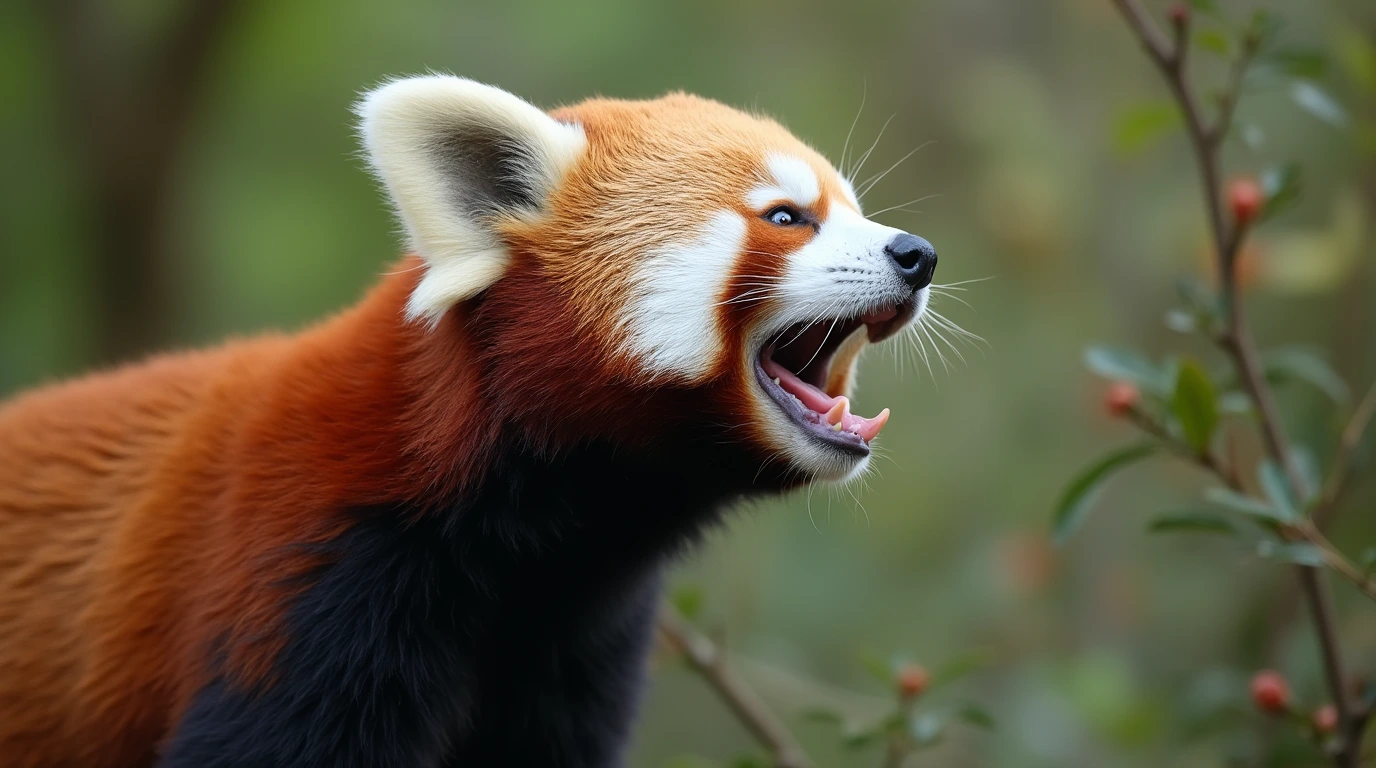Red pandas may be solitary animals, but they have developed a fascinating communication system that allows them to interact effectively with others. Whether marking their territory, signaling distress, or attracting a mate, they rely on a combination of vocalizations, body language, and scent marking to convey messages. Each method serves a distinct purpose, helping them navigate social interactions while maintaining their independence
In this article, we will explore the different ways red pandas communicate with each other, from their unique vocal sounds to their use of scent markings to establish dominance and reproductive status. We’ll also examine how communication changes during the mating season, the differences between wild and captive red pandas, and how cubs interact with their mothers. By the end, you’ll gain a deeper understanding of how these elusive creatures use subtle but effective signals to survive and thrive in their forest habitats
How Red Pandas Communicate With Each Other

Communication is essential for red pandas, even though they are largely solitary animals. They rely on a combination of vocalizations, body language, and scent marking to interact with others, establish their territory, and signal their reproductive status. Each method plays a crucial role in their survival, helping them avoid conflicts, find mates, and care for their young
Vocalizations and Their Meanings
While red pandas are not the most vocal mammals, they do produce a range of distinctive sounds to communicate. One of their most common vocalizations is a high-pitched bleat, which is often heard during the breeding season when males use it to court females. These bleats serve as a non-aggressive way to express interest and maintain contact over long distances. In contrast, females may respond with twittering or chirping sounds, especially when interacting with their cubs or signaling readiness to mate
In addition to mating-related calls, red pandas produce growls, grunts, and barks, particularly when defending their territory. A sharp bark is typically a warning signal used to deter intruders, while low growls or grunts may be signs of agitation during a confrontation. If a red panda feels seriously threatened, it may emit a loud squeal, a distress call that can alert other red pandas in the area
Interestingly, researchers have noted that red pandas in captivity sometimes develop unique vocal patterns in response to human caretakers. While wild red pandas use vocalizations primarily for reproduction and territorial disputes, those in zoos may become more vocal due to frequent social interactions. This suggests a level of adaptability in their communication methods, depending on their environment
Body Language and Visual Signals
Beyond vocalizations, red pandas rely heavily on body language to communicate their emotions and intentions. One of their most well-known defensive behaviors is standing on their hind legs, a posture they use when they feel threatened. This stance makes them appear larger and more intimidating, serving as a warning to predators or rivals. If this display fails to deter a threat, they may follow up with swipes of their sharp claws or a quick escape into the trees
Other visual signals include tail movements and head gestures. Red pandas often use their bushy tails for balance while climbing, but they can also raise or flick them in response to external stimuli. A slightly arched tail, combined with slow head movements, may indicate curiosity or mild alertness, while a stiff, upright tail often signals agitation or dominance. When two red pandas encounter each other, subtle cues such as ear positioning and head lowering help determine whether the interaction will be peaceful or confrontational
Juvenile red pandas also use body language extensively during play. Cubs engage in gentle pawing, rolling, and chasing behaviors, which serve as practice for future interactions. These playful movements help young red pandas develop coordination and recognize social cues they will use as adults
The Role of Scent Marking in Communication
Perhaps the most important form of communication for red pandas is scent marking, which allows them to establish territory and convey information about their identity and reproductive status. They have specialized scent glands located near their anogenital region and on the soles of their feet, which release chemical markers onto trees, rocks, and other surfaces. These scent markings act as a form of “messaging,” providing details about an individual’s sex, age, and dominance level
Urine marking is another common way red pandas communicate. By urinating on strategic locations throughout their territory, they leave behind chemical signatures that help prevent conflicts with other red pandas. During the breeding season, these scent marks become even more frequent, allowing males and females to locate potential mates. Males often invest more time in patrolling and reinforcing their scent boundaries, ensuring that competitors are aware of their presence
Red pandas also use scent marking to identify familiar individuals. Cubs recognize their mothers through scent, while adults can distinguish neighbors from strangers based on their chemical trails. This olfactory communication is particularly useful in the dense forests where red pandas live, where visibility is often low and vocal calls may not travel far
For further details on how red pandas use vocalizations and scent marking, you can explore the Smithsonian National Zoo’s article on red panda communication, which provides additional insights into their behavior
Factors That Influence Red Panda Communication

While red pandas rely on vocalizations, body language, and scent marking to communicate, their interactions are influenced by various factors. The breeding season, habitat conditions, and whether they live in the wild or captivity all play a role in shaping their communication patterns. These influences determine how often they vocalize, how frequently they mark their territory, and how they interact with other red pandas
How Communication Changes During Mating Season
The mating season, which occurs between January and March, is when red pandas become significantly more vocal and active in their communication. During this time, males and females increase their scent-marking behaviors, frequently rubbing their anogenital glands against tree trunks and leaving urine trails to signal reproductive availability. These chemical cues help potential mates locate each other within the dense forest, reducing the need for direct confrontations
Vocal communication also becomes more pronounced during this period. Males produce persistent bleating sounds, a high-pitched vocalization used to court females and signal their presence to competitors. Females, in turn, respond with shorter, more rhythmic vocalizations, indicating whether they are receptive to mating. If a rival male enters another’s territory, aggressive vocal displays such as barking and growling may occur, often accompanied by defensive posturing
Once a pair has mated, communication shifts toward maternal care. Pregnant females seek out nesting sites in hollow trees or dense foliage, where they will later give birth. After birth, mothers use soft twittering and humming sounds to communicate with their cubs, ensuring they remain close and protected. These vocalizations help strengthen the bond between mother and offspring, providing a critical form of early communication for cub survival
Differences in Communication Between Wild and Captive Red Pandas
The environment in which red pandas live significantly impacts how they communicate. In the wild, where food is scarce and territories are large, scent marking becomes the primary method of communication. Since red pandas are solitary animals, they rely on chemical signals left on trees and rocks to convey their presence rather than direct social interactions. Wild red pandas tend to be quieter, using vocalizations mainly during mating season or in moments of aggression
In captivity, however, red pandas are housed in closer proximity to others, leading to more frequent vocal exchanges and body language displays. Zookeepers have observed that captive red pandas often develop unique vocal patterns, sometimes responding to humans with sounds not typically heard in the wild. Additionally, because food is readily available and there is no need to defend large territories, scent marking occurs less frequently than in the wild
Captive red pandas may also exhibit more social behaviors, engaging in playful interactions that are less common in the wild. This suggests that while red pandas are naturally solitary, their communication methods can adapt to changes in their environment. Despite these differences, both wild and captive red pandas retain their innate communication instincts, including defensive posturing and scent-based territorial marking
How Red Panda Cubs Interact With Their Mothers and Siblings
Red panda cubs rely entirely on their mothers for communication in the early months of life. Born blind and deaf, they are completely dependent on touch, scent, and vocalizations to interact with their mother. When hungry or in distress, cubs produce high-pitched whimpers or twittering calls, prompting the mother to respond with grooming or feeding. These early sounds help establish a strong maternal bond, ensuring the cubs receive the care they need
As cubs grow, they begin to communicate through play behaviors, using gentle pawing, rolling, and tail movements to interact with their siblings. These playful actions are essential for developing motor skills and learning the body language cues they will use as adults. Cubs also observe their mother’s scent-marking habits, gradually mimicking her actions as they prepare for independence
By the time they reach six to eight months old, red panda cubs start experimenting with scent marking and adopting more complex body language. They practice defensive posturing, learning how to use tail movements and ear positioning to express dominance or submission. As they become more independent, their reliance on vocal communication decreases, and they transition to the scent-based and visual signals used by adult red pandas
For further insights into how captive and wild red pandas communicate, you can explore the Toronto Zoo’s article on red panda behavior, which details their interactions in different environments
How Red Pandas Transition Through Their Daily Communication Cycle

The way red pandas communicate is not static—it changes throughout the day based on their activity levels, interactions with other individuals, and environmental factors. Their daily routine involves distinct periods of vocalization, scent marking, and body language displays, each serving a specific purpose in their solitary lifestyle
Morning: Scent Marking and Territory Patrols
As dawn breaks, red pandas begin their day by patrolling their territory, a routine that involves extensive scent marking to reinforce their presence. Using their anogenital scent glands, they rub against tree trunks, branches, and rocks, leaving chemical signals that inform other red pandas about their identity, reproductive status, and boundaries. These markings are crucial for avoiding unnecessary conflicts, as they allow individuals to recognize occupied areas and avoid direct confrontations
While moving through their territory, red pandas also engage in urine marking, depositing small amounts of urine on surfaces as an additional layer of territorial communication. This scent-based messaging is particularly important during the breeding season when males and females use these signals to locate potential mates. In addition to scent marking, red pandas may produce occasional vocalizations, such as soft bleats or grunts, when encountering another individual within their range
Midday: Resting and Minimal Communication
As temperatures rise, red pandas retreat to shaded areas or high tree branches, where they spend several hours resting. Since they rely on a low-calorie bamboo diet, they must conserve energy, leading to a period of reduced communication. During this time, they rarely vocalize, as there is little need for active interaction
Despite their inactivity, they remain alert to their surroundings, using subtle body language cues to monitor nearby movements. If disturbed, a red panda may flick its tail, flatten its ears, or raise its head as a sign of mild irritation. If the perceived threat continues, they may escalate their response by standing on their hind legs or emitting a warning bark. However, in most cases, midday is a quiet period for red pandas, with limited social engagement
Evening: Social Interactions and Vocal Communication
As the sun sets, red pandas become active once again, resuming their foraging and territorial marking routines. This period is when most vocal interactions occur, particularly if multiple individuals are within proximity. During the breeding season, males increase their bleating sounds to signal their presence to females, while females respond with soft twittering or chirping noises to indicate receptiveness. These vocal exchanges play a crucial role in mating success, ensuring that individuals can locate compatible partners
Territorial disputes are also more likely in the evening hours, as overlapping ranges bring red pandas into closer contact. If two males cross paths, they may engage in aggressive posturing, using growls, tail arching, and standing displays to establish dominance. Physical confrontations are rare, as red pandas generally prefer to resolve conflicts through intimidation rather than direct combat
Juvenile red pandas, still learning social behaviors, use this time to interact with their mothers and siblings. Young cubs engage in play fighting, paw swiping, and tail wrestling, which help them develop essential communication skills. As they grow older, these playful behaviors transition into more serious scent-marking and body language displays, preparing them for independent life
Night: Final Scent Marking and Settling Into Rest
Before settling down for the night, red pandas conduct one last round of scent marking, reinforcing the boundaries they patrolled earlier in the day. These nighttime markings ensure that any red pandas passing through will recognize the territory as occupied, reducing the likelihood of conflicts
Once they find a suitable resting spot, usually high in the treetops, red pandas curl up with their bushy tails wrapped around their bodies, a position that helps retain warmth. Although largely inactive during the night, they remain semi-alert to environmental sounds and movements. If startled, they may respond with a quick vocal warning or shift their body posture to assess the situation. However, unless threatened, red pandas spend most of the night resting, conserving energy for the next day’s activities
For additional insights into how red pandas communicate through scent, vocalizations, and body language, you can explore SAFE Worldwide’s guide on red pandas, which provides further details on their behavioral patterns













